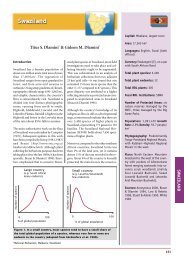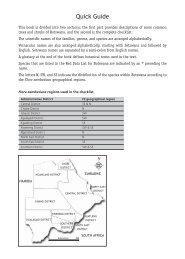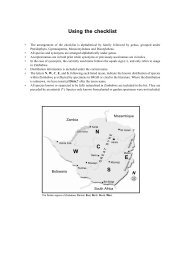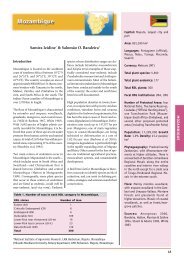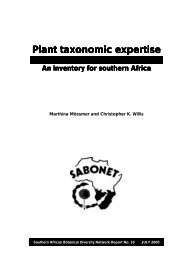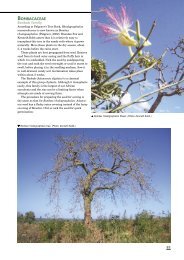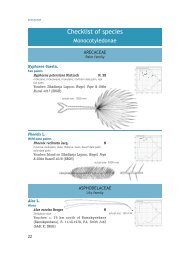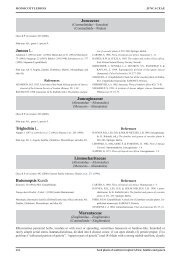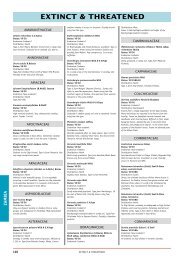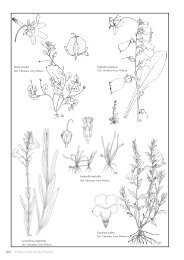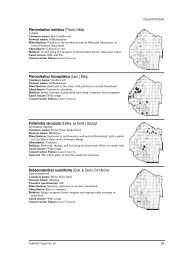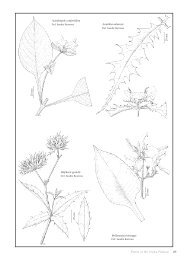141-172 - SABONET
141-172 - SABONET
141-172 - SABONET
You also want an ePaper? Increase the reach of your titles
YUMPU automatically turns print PDFs into web optimized ePapers that Google loves.
groups was often held up by a couple of boxes of<br />
specimens needing translation of their data; the<br />
company helps us all by allowing us to vent. We<br />
have also obtained the assistance of Ms Anabela<br />
Almeida in translating our Portuguese-English<br />
labels.<br />
Another notable milestone will be the publication<br />
of our new species list, devotedly edited by Pat<br />
Craven. This will be a boon to many biologists<br />
working in Namibia and we already have a waiting<br />
list for the limited number of copies we plan to<br />
publish.<br />
Our next most pressing need is for a researcher to<br />
concentrate on the useful plants that are being<br />
overharvested in Namibia at present, with<br />
Harpagophytum procumbens being the worst<br />
affected thus far. We feel that this rapidly growing<br />
problem needs someone’s undivided attention<br />
(although we would forgive them for looking at<br />
effects of fire in the northeast of Namibia too).<br />
Well, that’s it for now. Regards to all<br />
<strong>SABONET</strong>ers from us here at WIND.<br />
Coleen Mannheimer<br />
News from South Africa<br />
Ted Oliver, from the<br />
Compton Herbarium<br />
in Cape Town (NBG<br />
& SAM), received his<br />
PhD from the University<br />
of Cape Town<br />
during June 1999. His<br />
thesis was entitled<br />
“Systematic studies<br />
in the tribe Ericeae<br />
(Ericaceae-Ericoideae)”.<br />
Anna Fellingham<br />
(also from NBG &<br />
SAM) received an MSc at the same ceremony. Her<br />
study was on inflorescences in the genus<br />
Cliffortia.<br />
Information supplied by Ted Oliver<br />
<strong>SABONET</strong> News Vol. 4 No. 2 August 1999<br />
Southern African Society of Aquatic<br />
Scientists conference<br />
The Southern African Society of Aquatic Scientists<br />
(SASAQS) held its 35th conference at<br />
Swakopmund, Namibia, from 27 June to 1 July<br />
1999. The delegates were from Namibia, South<br />
Africa, Botswana, Zimbabwe, Zambia, Kenya,<br />
Uganda, Lesotho, Malawi, Tanzania, Belgium, the<br />
United States, the United Kingdom and Germany.<br />
The theme of this years conference was research,<br />
conservation, and the management of aquatic<br />
resources in southern Africa. The scientific sessions<br />
were held at the Auditorium of the Ministry<br />
of Fisheries and Marine Resources and at one of<br />
Swakopmund’s holiday resorts—the Alte Brücke<br />
Conference Centre. The two auditoria were within<br />
(brisk!!) walking distance of each other so it was<br />
possible to attend presentation at either of the<br />
parallel sessions.<br />
The venue was idyllic—for us South Africans<br />
(especially from Pretoria and Johannesburg) it was<br />
wonderful to be in such a peaceful and friendly<br />
town. The only hazard of walking between the two<br />
venues was the “urbanised” pelicans who used the<br />
street lights as their perches—it was advisable to<br />
give the lamp posts a wide berth. Seeing these<br />
wetland birds every day and hearing the waves<br />
crashing against the rocks in front of the Fisheries<br />
and Marine Resources building reminded one that<br />
this whole conference was all about the management<br />
of our wetlands in southern Africa.<br />
The conference was officially opened by the<br />
Namibian Minister of Agriculture and Rural<br />
Development, Mr Helmuth Angula. In his opening<br />
speech he highlighted some of the institutions that<br />
were actively involved in research on the aquatic<br />
resources in Namibia and also water resources that<br />
they share with neighbouring countries. Many of<br />
their research efforts are envied by other countries,<br />
especially in the field of fisheries research and<br />
management, but they regard themselves as “data<br />
poor” when it comes to fully understanding their<br />
aquatic systems. This statement can be applied to<br />
all the southern African countries, certainly from a<br />
botanical point; we do not know what plants occur<br />
in our wetlands. We all know that the plants in any<br />
wetland are the primary producers and form a vital<br />
167



